Reactor Pilot Process Cooling and Heating System
In the fields of chemical engineering, pharmaceuticals, and materials science, reactors are experimental equipment for reactions. The pilot reaction process is a link from laboratory scale to industrial production, and accurate control of reaction conditions is of great concern. Among them, the refrigeration and heating temperature control system during the pilot reaction process of the reactor is the temperature control part of the reactor, which directly affects the efficiency of the reaction and the quality of the product.
The main function of the refrigeration and heating temperature control system is to provide a stable temperature environment during the reaction process to meet the specific requirements of different chemical reactions on temperature conditions. This system usually includes components such as refrigeration units, heating elements, temperature sensors and controllers. By accurately controlling the refrigeration and heating power, it can achieve rapid response and stable maintenance of the temperature in the reactor.
During the pilot reaction process, the performance of the refrigeration, heating and temperature control system directly affects key indicators such as reaction rate, product yield and reaction selectivity. Therefore, it is important to optimize the refrigeration, heating and temperature control system during the pilot reaction process of the reactor. First, appropriate refrigeration and heating methods and control strategies should be selected based on specific reaction types and conditions. For example, for exothermic reactions, heating first and then cooling can be used to avoid excessive temperature during the reaction; while for endothermic reactions, it is necessary to ensure that the heating power is sufficient to ensure that the reaction proceeds smoothly.
Secondly, improving the temperature control accuracy and stability of the refrigeration and heating temperature control system during the reactor pilot reaction process is also the key to optimization. This can be achieved by optimizing the layout and calibration of temperature sensors, improving the computing speed and algorithm accuracy of the controller, etc. In addition, dynamic temperature control technology, such as PID control, fuzzy control, etc., can also be used to improve the system’s adaptive ability and anti-interference ability.
In addition, the safety of the refrigeration, heating and temperature control system during the pilot reaction process of the reactor is also an issue that cannot be ignored. During the design and use process, safety measures such as explosion protection and leakage prevention of the system should be fully considered to ensure that the power supply can be cut off in time or other emergency measures can be taken under abnormal circumstances to prevent accidents.
To sum up, the refrigeration and heating temperature control system plays a role in the pilot reaction process of the reactor. By optimizing the design and use of the system, the efficiency of the reaction and the quality of the product can be significantly improved, which provides services for chemical industry, pharmaceuticals, materials science, etc. Provide strong support for research and production in the field.
Wir bieten die Entwicklung und Herstellung kompletter Temperaturkontrollsysteme an. Von Standardmodellen bis hin zu kompletten kundenspezifischen Produkten. Wir haben uns auf den Kundenservice spezialisiert und sind bestrebt, jedem Kunden zu helfen, das optimale Temperaturkontrollsystem für seinen spezifischen Bedarf zu finden.
Wir bieten maßgeschneiderte Lösungen, die nicht dem Standard entsprechen. Es sind sowohl einzelne Kühlaggregate als auch kombinierte Kühl- und Heizaggregate erhältlich.
E-Mail: lilia@lneya.com WeChat ID: +8615251628237 WhatsApp: +86 17851209193


Kühl- und Heizsysteme (Serie SUNDI)
- Temperaturbereich: -120℃ ~ +350℃
- Hochpräzise, intelligente Temperaturregelung
- Kühlleistung: 0,5kW ~ 1200kW
- Vollständig geschlossenes System zur Verlängerung der Lebensdauer des Thermofluids
- Jedes Gerät wird mehr als 12 Stunden lang einem Belastungstest unterzogen.
| Temperaturbereich | Serie -10 ~ +150°C | Serie -25 ~ +200°C | Serie -25 ~ +300°C | Serie -45 ~ +250°C | Serie -45 ~ +300°C | Serie -60 ~ +250°C | Serie -60 ~ +300°C | Serie -70 ~ +250°C | Serie -80 ~ +250°C | Serie -90 ~ +250°C | Serie -100 ~ +100°C | ||
| Kühlleistung | 1,5 ~ 15kW | 1 ~ 200kW | 1 ~ 200kW | 0,45 ~ 200kW | 0,9 ~ 25kW | 0,25 ~ 60kW | 0,75 ~ 25kW | 0,4 ~ 15kW | 0,3 ~ 80kW | 0,2 ~ 80kW | 0,45 ~ 80kW | ||
| Hinweis: Jeder Temperaturbereich von -150℃ ~ +350℃ und jede Kühlleistung kann angepasst werden | |||||||||||||
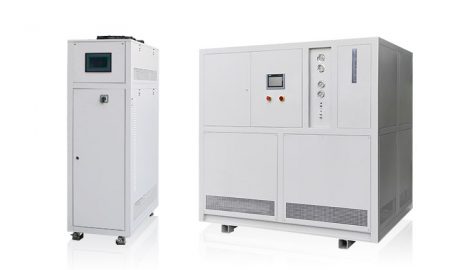
Kühl- und Heizsysteme (WTD-Serie)
- (Mikrokanal / Röhrenreaktoren spezialisiert)
- Temperaturbereich: -70℃ ~ +300℃
- Leistungsstarke Umwälzpumpe, stabilere Temperaturregelung
- Breiter Temperaturbereich zur Erfüllung der Anforderungen mehrerer Branchen
- Jedes Gerät wird mehr als 12 Stunden lang einem Belastungstest unterzogen.
| Temperaturbereich | -70°C ~ +300°C | -45°C ~ +250°C | -70°C ~ +200°C | ||||||
| Kühlleistung | 1.1 ~ 7.5kW | 1.5 ~ 5.5kW | 11 ~ 50kW | ||||||
| Hinweis: Jeder Temperaturbereich von -150℃ ~ +350℃ und jede Kühlleistung kann angepasst werden | |||||||||

Umwälzpumpen für Kühlung und Heizung
- Temperaturbereich: -45℃ ~ +250℃
- Emerson Copeland Kompressor, zuverlässige Qualität
- Selbstdiagnosefunktion, mehrere Sicherheitsschutzvorrichtungen
- Vollständig geschlossenes System zur Verlängerung der Lebensdauer des Thermofluids
- Jedes Gerät wird mehr als 12 Stunden lang einem Belastungstest unterzogen.
| Temperaturbereich | Serie -25°C ~ +200°C | Serie -45°C ~ +250°C | |||||||
| Kühlleistung | 1 ~ 15kW | 0,25 ~ 15kW | |||||||
| Hinweis: Jeder Temperaturbereich von -150℃ ~ +350℃ und jede Kühlleistung kann angepasst werden | |||||||||
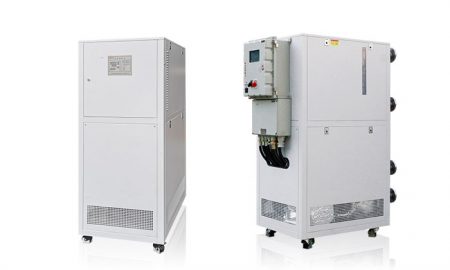
Heizungsumwälzpumpen
- Temperaturbereich: +50℃ ~ +300℃
- Große Wärmeaustauschfläche und schnelle Aufheizgeschwindigkeit
- Selbstdiagnosefunktion, mehrere Sicherheitsschutzvorrichtungen
- Geschlossenes Kreislaufsystem, kein Ölnebel bei hohen Temperaturen
- Jedes Gerät wird mehr als 12 Stunden lang einem Belastungstest unterzogen.
| Temperaturbereich | +50°C ~ +170°C (UC-Serie) | +50°C ~ +300°C (UC-Serie) | +50°C ~ +300°C (UST-Serie) | ||||||
| Heizleistung | 5,5 ~ 15kW | 3,5 ~ 130kW | 3,5 ~ 95kW | ||||||
| Hinweis: Jeder Temperaturbereich von -150℃ ~ +350℃ und jede Kühlleistung kann angepasst werden | |||||||||
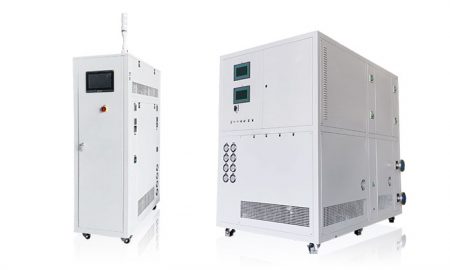
TES-Serie (Temperaturregelung für Kraftstoff- und Öltests)
- Temperaturbereich: -85℃ ~ +250℃
- Siemens PLC-Steuerung und anderes Markenzubehör
- Selbstdiagnosefunktion, mehrere Sicherheitsschutzvorrichtungen
- Vollständig geschlossenes Kreislaufsystem, kein Ölnebel bei hohen Temperaturen
- Jedes Gerät wird mehr als 12 Stunden lang einem Belastungstest unterzogen.
| Temperaturbereich | Serie -45°C ~ +250°C | Serie -85°C ~ +200°C | Serie -60°C ~ +200°C | ||||||
| Kühlleistung | 0,3 ~ 25kW | 0,25 ~ 25kW | 3 ~ 60kW | ||||||
| Hinweis: Jeder Temperaturbereich von -150℃ ~ +350℃ und jede Kühlleistung kann angepasst werden | |||||||||
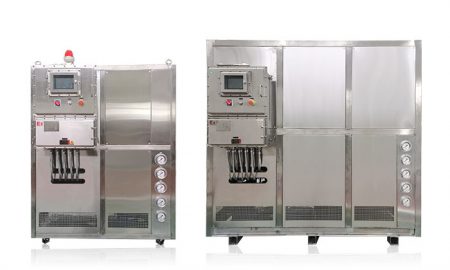
TCU Multireaktoren Temperaturkontrollsystem
- Temperaturbereich: -120℃ ~ +250℃
- Versiegelte, wiederholbare Temperaturkontrolle
- Eingebautes Thermoöl-Hilfssystem für elektrische Heizung
- Hinzufügen von Kälte- und Wärmequellen-Wärmetauschermodulen je nach Bedarf
- Jedes Gerät wird mehr als 12 Stunden lang einem Belastungstest unterzogen.
| Temperaturbereich | Serie -45°C ~ +250°C | -120°C ~ +250°C Reihe | Kundenspezifisches Temperaturkontrollsystem | RT+10°C ~ +135°C | |||||
| Heizleistung | 25 ~ 80kW | 25 ~ 80kW | Benutzerdefiniert | 25 ~ 300kW | |||||
| Hinweis: Jeder Temperaturbereich von -150℃ ~ +350℃ und jede Kühlleistung kann angepasst werden | |||||||||

Rückkühler / Umwälzkühler
Die Kältemaschine kann in verschiedenen Industrien und Labors eingesetzt werden und unterstützt kundenspezifische Designs.
| Temperaturbereich | Serie -25°C ~ +30°C | -45°C ~ +30°C Reihe | Serie -60°C ~ -20°C | Serie -80°C ~ -20°C | Serie -120°C ~ -70°C | ||||
| Kühlleistung | 0,8 ~ 30kW | 0,75 ~ 12kW | 0,4 ~ 6kW | 0,2 ~ 6kW | 0,3 ~ 5kW | ||||
| Hinweis: Jeder Temperaturbereich von -150℃ ~ +350℃ und jede Kühlleistung kann angepasst werden | |||||||||
 Mini-Kaltwassersätze / Kleinkaltwassersätze
Mini-Kaltwassersätze / Kleinkaltwassersätze
Die Kältemaschine kann in verschiedenen Industrien und Labors eingesetzt werden und unterstützt kundenspezifische Designs.
| Temperaturbereich | -18°C ~ +30°C | +5°C ~ +35°C Reihe | |||||||
| Kühlleistung | 0,35 ~ 0,9kW | 1,8 ~ 50kW | |||||||
| Hinweis: Jeder Temperaturbereich von -150℃ ~ +350℃ und jede Kühlleistung kann angepasst werden | |||||||||

Niedertemperatur-Kühlgeräte
Wir haben uns auf die Herstellung von Niedertemperaturkältemaschinen mit einem Temperaturregelbereich von bis zu -150°C spezialisiert, die den Kühlbedarf verschiedener Branchen decken.
| Temperaturbereich | Serie -25°C ~ -5°C | Serie -45°C ~ -10°C | Serie -60°C ~ -10°C | Serie -80°C ~ -30°C | Serie -110°C ~ -50°C | Serie -150°C ~ -110°C | |||
| Kühlleistung | 12 ~ 360kW | 6 ~ 180kW | 6 ~ 180kW | 4 ~ 180kW | 2 ~ 120kW | 2,5 ~ 11kW | |||
| Hinweis: Jeder Temperaturbereich von -150℃ ~ +350℃ und jede Kühlleistung kann angepasst werden | |||||||||
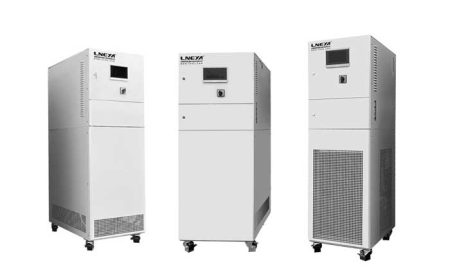
Hochtemperatur-Kühlgeräte
Die Kältemaschine kann in verschiedenen Industrien und Labors eingesetzt werden und unterstützt kundenspezifische Designs.
| Temperaturbereich | +5°C ~ +40°C | -25°C ~ +40°C | -45°C ~ +40°C | -80°C ~ +80°C | -100°C ~ +80°C | ||||
| Kühlleistung | 6 ~ 40kW | 2 ~ 15kW | 1 ~ 8kW | 0,6 ~ 3kW | 1,5 ~ 3kW | ||||
| Hinweis: Jeder Temperaturbereich von -150℃ ~ +350℃ und jede Kühlleistung kann angepasst werden | |||||||||
 LNEYA
LNEYA
 简体中文
简体中文


















































































